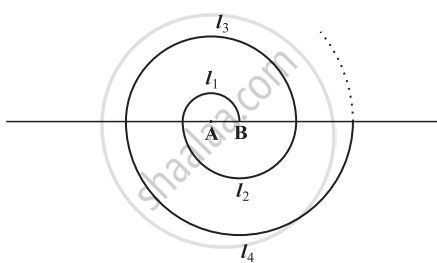Advertisements
Advertisements
Question
In an AP given d = 5, S9 = 75, find a and a9.
Solution
Here, d = 5 and S9 = 75 (given)
∵ Sn = `"n"/2` [a + an]
⇒ `S_9 = 9/2[a + a_9] = 75`
⇒ 3a + 3a9 = 50 ...(1)
∵ `S_n = n/2[2a + (n - 1) xx d]`
⇒ `S_9 = 9/2[2a + (9 - 1) xx 5] = 75`
⇒ `9/2[2a + 40] = 75`
⇒ 9a + 180 = 75
⇒ 9a = 75 - 180
⇒ 9a = -105
⇒ a = `-105/9`
⇒ a = `-35/3` ...(2)
By substituting the value of a from equation (2) in equation (1),
`3 xx (-35/3) + 3a_9 = 50`
⇒ -35 + 3a9 = 50
⇒ 3a9 = 50 + 35
⇒ 3a9 = 85
⇒ a9 = `85/3`
APPEARS IN
RELATED QUESTIONS
Find the number of natural numbers between 101 and 999 which are divisible by both 2 and 5.
If the ratio of the sum of first n terms of two A.P’s is (7n +1): (4n + 27), find the ratio of their mth terms.
In an AP: Given a = 5, d = 3, an = 50, find n and Sn.
Show that a1, a2,..., an... form an AP where an is defined as below:
an = 9 − 5n
Also, find the sum of the first 15 terms.
A spiral is made up of successive semicircles, with centres alternately at A and B, starting with centre at A of radii 0.5, 1.0 cm, 1.5 cm, 2.0 cm, .... as shown in figure. What is the total length of such a spiral made up of thirteen consecutive semicircles? (Take `pi = 22/7`)

[Hint: Length of successive semicircles is l1, l2, l3, l4, ... with centres at A, B, A, B, ... respectively.]
Find the sum of the first 40 positive integers divisible by 5
The first term of an A.P. is 5, the last term is 45 and the sum of its terms is 1000. Find the number of terms and the common difference of the A.P.
If 4 times the 4th term of an AP is equal to 18 times its 18th term then find its 22nd term.
If ` 4/5 ` , a , 2 are in AP, find the value of a.
The sum of 5th and 9th terms of an A.P. is 30. If its 25th term is three times its 8th term, find the A.P.
Let there be an A.P. with first term 'a', common difference 'd'. If an denotes in nth term and Sn the sum of first n terms, find.
Write the value of a30 − a10 for the A.P. 4, 9, 14, 19, ....
Write the nth term of the \[A . P . \frac{1}{m}, \frac{1 + m}{m}, \frac{1 + 2m}{m}, . . . .\]
If in an A.P. Sn = n2p and Sm = m2p, where Sr denotes the sum of r terms of the A.P., then Sp is equal to
In an AP. Sp = q, Sq = p and Sr denotes the sum of first r terms. Then, Sp+q is equal to
The sum of n terms of an A.P. is 3n2 + 5n, then 164 is its
The common difference of the A.P.
Obtain the sum of the first 56 terms of an A.P. whose 18th and 39th terms are 52 and 148 respectively.
Jaspal Singh repays his total loan of Rs. 118000 by paying every month starting with the first instalment of Rs. 1000. If he increases the instalment by Rs. 100 every month, what amount will be paid by him in the 30th instalment? What amount of loan does he still have to pay after the 30th instalment?
The 5th term and the 9th term of an Arithmetic Progression are 4 and – 12 respectively.
Find:
- the first term
- common difference
- sum of 16 terms of the AP.
